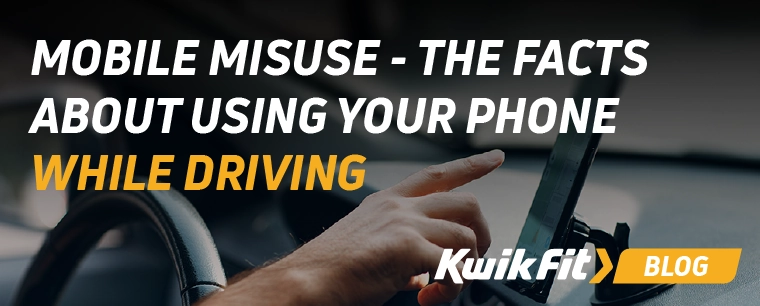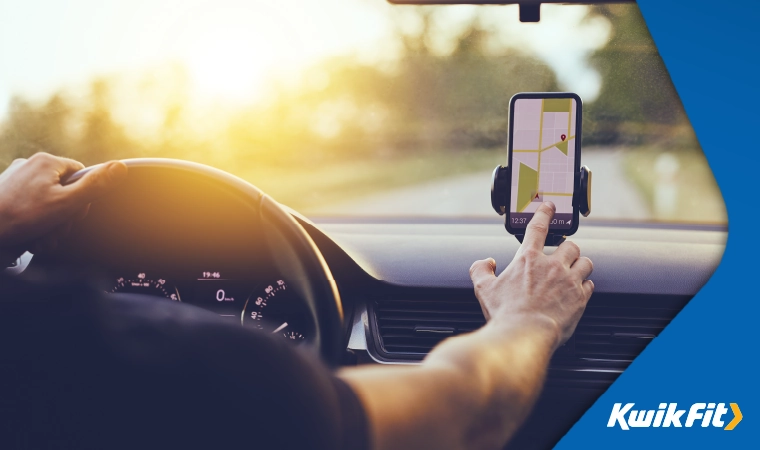Mobile Misuse - The Facts About Using Your Mobile Phone While Driving
Kwik Fit | Thursday 3rd October 2024 9:00am

From auspicious, suitcase-sized beginnings, the mobile phone has now irreversibly become a part of everyday life. In fact, most people readily admit that they’d struggle to live without their trusty mobile. From getting the latest news, communicating with friends, listening to music and even controlling the appliances in the home, there really is an app for everything. In fact, we’ve become so inseparable from our phones that it’s no wonder that mobile phone use while driving is increasingly becoming a big problem – that’s why campaigners are keen to raise awareness of the dangers.
If you’ve ever considered answering that call, replying to a text, or actively using your mobile while driving, here are the facts as to why you should leave that handset well alone.
The research
The use of mobile phones while driving has become a hot topic lately and there is plenty of eye-opening research to discourage drivers from using their phones. However, the RAC recently found that drivers (particularly young drivers) are increasingly using their phones while driving with an estimated 11 million drivers breaking the law by doing so. 20% of the 1,700 people surveyed thought it was ok to check their phone while driving whereas only 14% said it was acceptable in the same survey in 2014.
Every year, dozens of people lose their lives in the UK as a result of mobile phone use, but it’s thought that thousands of non-fatal accidents happen because the driver was using their phone. However, it’s difficult to try to put an accurate figure on the number of accidents caused as a direct result of mobile phone use because they often rely on self-reporting in non-fatal accidents – and many cases are recorded as ‘in-vehicle distraction’, which could be something as simple as a conversation with a passenger.
That said, the road safety campaign, Think!, claims that studies have shown how phones are a major distraction and that drivers using mobile phones are slower to recognise and react to hazards. Even careful drivers can have a split-second lapse in concentration when a call or text comes in that could be the difference between stopping safely and a crash.
Meanwhile across the pond...
Researchers in America studied dash-cam footage of 2,200 accidents involving young drivers aged 17-19 and found that as many as 1 in every 8 accidents were caused by the driver losing concentration because they were using their phone.
The current law on mobile phone use
Since 2003, it’s been illegal to use a mobile phone while actually driving a car, but the wording until recently was that it was illegal to use a mobile phone for “interactive communication” – meaning to hold your phone and use it for “communication”. This wording made a lot of sense when it was made in 2003 because phones could pretty much only be used for communication in 2003 (we hope nobody was actually trying to play Snake or Tetris while driving).
Now, however, phones are able to do a lot more things – many of which can still provide serious distractions while driving. An example given on the government website is of a man who took a phone video of the aftermath of a car accident while driving past it. The court decided that he wasn’t in offence of the law because using it to take a video didn’t count as using it for “communication”.
The wording, therefore, has recently been expanded to include any use of a mobile phone, tablet, sat nav, or any device that’s able to send and receive data (even if you’re using it in offline mode). This applies any time that you’re driving, regardless of whether you’re stopped at traffic lights, queuing in traffic, or almost any other time that you’re in control of a vehicle.
In fact, the only exceptions to this are:
- Holding your phone in order to use it for contactless payments (such as in a drive-through) – your vehicle needs to be static for this to apply.
- When you need to call an emergency service and it’s unsafe or impractical to pull over and stop.
Being in breach of this law means you could get an immediate fine of £200 and have 6 points added to your licence (which is up significantly from the £100 fine and 3 points that applied until 2016).

No second chances for new drivers...
Crucially, you’re not given second chances if you’re a new driver and break this law. If you’ve received your licence within the last two years and are found to have broken this law, your licence will be revoked.
Now, this is slightly different from a “disqualification” insofar as you’ll be able to immediately reapply for a licence but you’ll have to redo both the theory and practical test before getting a new one – which can prove very costly and leave you for months without the ability to drive a car. So it’s not a risk worth taking!
More than just a phone
Smartphones these days are so much more than just phones that the name itself is arguably misleading. Most smartphone users spend far less time using the ‘phone’ features of their device to make calls than they do using text, social media, and other apps to communicate.
But herein lies the problem – many phone users believe it is more acceptable to read a text or send a message while driving than it is to take a call, as if the illegal act is putting your phone to your ear. In other words there’s a false belief that as long as you don’t use your phone as a ‘phone’, you’re ok.
The RAC’s survey found that only 14% of their respondents said they would take a quick call yet this increased to 20% when asked if they would check Facebook or another social media site. If you want to avoid getting into trouble with the law, you shouldn’t be picking up that phone at all.
Pokemon No...
It’s not just texting and messaging that pose a problem, mobile gaming has become big business. Popular but controversial games like Pokemon Go, which see players using geo-location services and augmented reality to track and catch ‘pocket monsters’, is a real cause for concern for the police and road safety organisations alike following a number of road accidents where the driver responsible was playing the game. The Journal for the American Medical Association recently carried out a study that found apps like Pokemon Go to be too distracting and have caused an estimated 110,000 road accidents.
Hands-free facts
So, the wording about using your phone tends to centre on using your phone – that is, holding it – but many drivers still use their phones as Sat Navs. This is actually permitted so long as you’re using a stable hands-free kit. You should still approach with caution, however, because the law states that if the police think you’re distracted and not in control of your vehicle, you could still get stopped or penalised – even when using a hands-free kit.
So, with the phone mounted on the dashboard you can make a call via Bluetooth for example, but if you have to look at and touch the screen for an extended period of time (i.e. to find a contact in your address book), you run the risk of being pulled over. The same rules apply to sat-navs – their in-car usage is generally acceptable but if the police catch you reprogramming a sat-nav while on the move and believe you are distracted, you will be penalised.
Advice for drivers
The advice is simple. While behind the wheel, don’t look at your phone under any circumstances, no matter how tempting it may be. The only exception allowed by law is to make an emergency call to 999 or 112. If you absolutely need to use your handset, make sure you pull over somewhere safe before accessing your phone.
Stay up to date with driving news
The best way to stay up to date with driving news and vehicle maintenance is to check out our blog – we have everything from deep-dive how-tos to interesting pieces on scenic drives.
Any facts, figures and prices shown in our blog articles are correct at time of publication.
Featured Articles
Is it Illegal to Drive With One Headlight?
Saturday 19th July 2025
Wondering if it’s illegal to drive with one headlight? Learn about the safety risks and penalties of illegal blown bulbs and why you should fix them promptly.
Air Con in EVs & Hybrids: Experts Answer Your Questions
Monday 30th June 2025
Does air con drain EV batteries? Can you use the air con while charging an electric car? Find out the answers to these questions & more from Kwik Fit’s experts.
Why Is Your Car Making a Noise? Fixes & Tips
Friday 13th June 2025
When your car starts making unexpected noises, it can certainly be quite disconcerting; it may be nothing to worry about, but here’s what you need to know.









